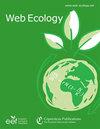亲近自然的管理对马尾松林分的空间结构有积极的改善作用
IF 2.4
3区 环境科学与生态学
Q2 ECOLOGY
引用次数: 5
摘要
摘要近自然管理(CTNM)是一种很有前途的林业管理方法,它集木材生产和生态服务功能于一体,可以改善森林的结构和质量。研究CTNM对林分空间结构单变量和双变量分布的影响,为评价CTNM在林业中的应用提供了科学依据。以马尾松人工林为研究对象,分析比较了马尾松人工林在选择性采伐和不加管理的CTNM8年条件下(青年期、中年期和近成熟期)的空间结构特征。我们使用了三个空间结构参数的单变量和双变量分布:混合(M),优势(U)和均匀角指数(W)。结果表明:CTNM对马尾松中、近成熟林空间结构的影响比幼林更为显著;ctnm显著提高了混合程度,促进了水平分布,从而由集群变为随机分布。此外,CTNM提高了马尾松中、近成熟林中混合度高、随机分布的乔木比例和混合度高、优势度高、随机分布的微结构乔木比例。总体而言,8年前实施的CTNM对马尾松林空间结构的改善具有积极作用,但目前的空间结构处于次优状态。进一步实施CTNM来调整混交和均匀角指数是必要的,根据这种林分结构参数频率分布方法的CTNM可以提高森林经营的成功率。本文章由计算机程序翻译,如有差异,请以英文原文为准。
Close-to-nature management positively improves the spatial structure of Masson pine forest stands
Abstract. Close-to-nature management (CTNM) has been proposed as a promising
forestry management approach to improve the structure and quality of
forests, which integrates wood production and ecological service functions.
Research on the effect of CTNM on the univariate and
bivariate distribution of the spatial structure of forest stands provides a
scientific basis for the evaluation of CTNM implemented in forestry. Here,
we analyzed and compared the spatial-structure characteristics of Masson
pine (Pinus massoniana) plantations (young, middle-age, and near-mature stages) under CTNM
8 years after selective cutting and unmanaged control. We used
univariate and bivariate distribution of three spatial-structure parameters:
mingling ( M ), dominance ( U ), and uniform-angle index ( W ). Results showed that
the effect of CTNM on spatial structure was more remarkable in middle-aged
and near-mature Masson pine forests compared with the young forest. CTNM
significantly improved mingling degree and promoted the horizontal
distribution, thereby changing from a cluster to a random distribution.
Moreover, CTNM improved the proportion of trees with a high mixing degree
and random distribution and the proportion of trees having a micro-structure
of random distribution with a high degree of mixture and dominance with a
high degree of mixture in middle-aged and near-mature Masson pine forest.
Overall, the implementation of CTNM 8 years ago showed a positive effect
on the improvement of the spatial structure of Masson pine forest, but the
present spatial structure is suboptimal. Further implementation of CTNM to
adjust the mingling and uniform-angle index is necessary, and CTNM according
to this method of frequency distribution of stand structure parameters can
improve the success of forest management.
求助全文
通过发布文献求助,成功后即可免费获取论文全文。
去求助
来源期刊

Web Ecology
Agricultural and Biological Sciences-Ecology, Evolution, Behavior and Systematics
CiteScore
4.60
自引率
0.00%
发文量
6
审稿时长
17 weeks
期刊介绍:
Web Ecology (WE) is an open-access journal issued by the European Ecological Federation (EEF) representing the ecological societies within Europe and associated members. Its special value is to serve as a publication forum for national ecological societies that do not maintain their own society journal. Web Ecology publishes papers from all fields of ecology without any geographic restriction. It is a forum to communicate results of experimental, theoretical, and descriptive studies of general interest to an international audience. Original contributions, short communications, and reviews on ecological research on all kinds of organisms and ecosystems are welcome as well as papers that express emerging ideas and concepts with a sound scientific background.
 求助内容:
求助内容: 应助结果提醒方式:
应助结果提醒方式:


